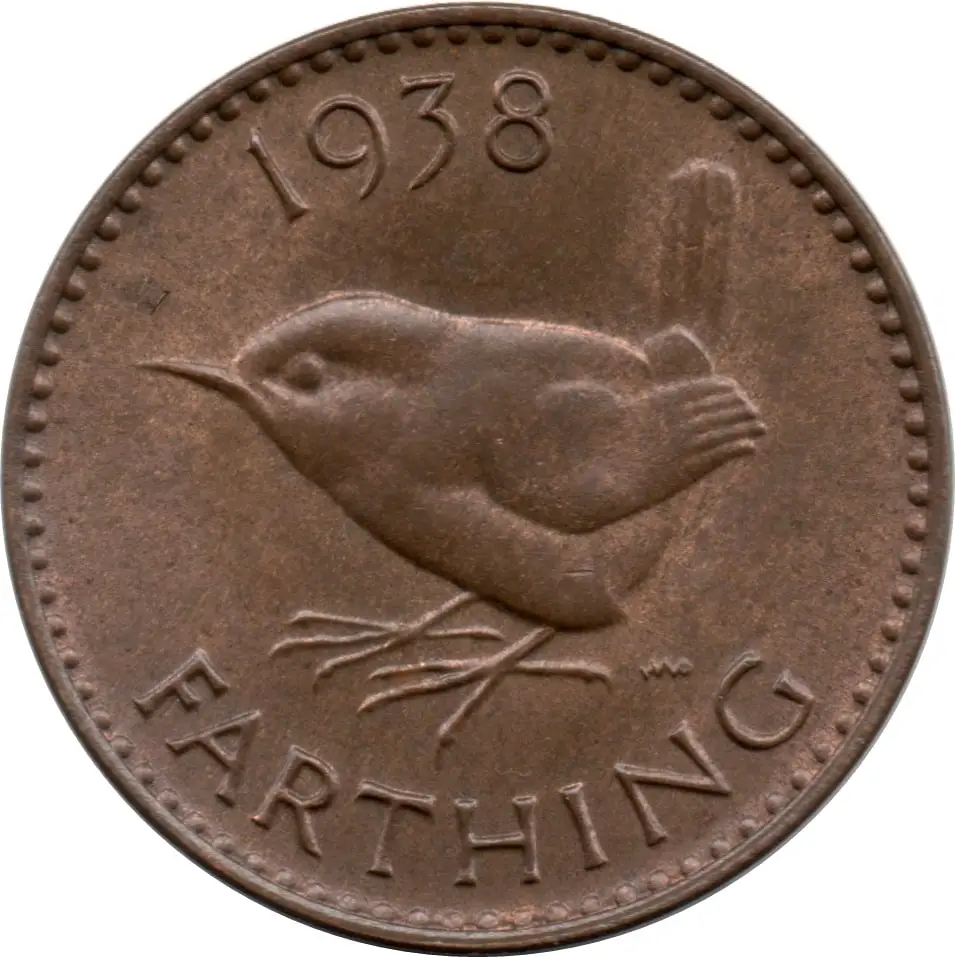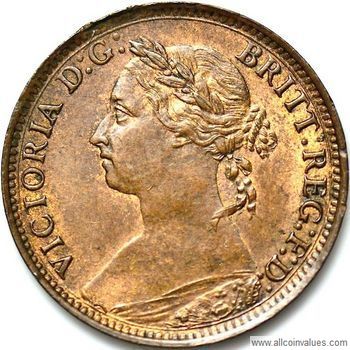Farthings were worth 1/4 of a penny during their circulation and have gone on to become sought after by coin collectors; but how much are they worth to collectors today?
It’s incredibly hard to give an exact value as the farthing was issued over hundreds of years; while some can be worth less than £1, there are some farthings that are worth thousands of pounds to the right buyer.
In this article, we’ll break down the extensive history of the farthing and give some examples of rare farthings that are worth a fortune.
Let’s get straight into it.
The History Of The Farthing
The farthing has an extensive history.
Spanning over hundreds of years, the farthing has been brought in and out of mintage several times. The farthing was officially made a denomination in 1272 under the rule of Edward I during a reform of the coinage at the time. The coin was struck in a mixture of silver and copper and was very small at only 10mm in diameter.
The farthing remained relatively unchanged through the years with the size slightly increasing and the coin becoming mostly struck in copper.
This was until the modern farthing was introduced into the UK currency system during the reign of Queen Victoria in 1860. The coins would now be minted in bronze and the reverse design depicted the iconic Britannia which can still be found on 50p coins to this day.
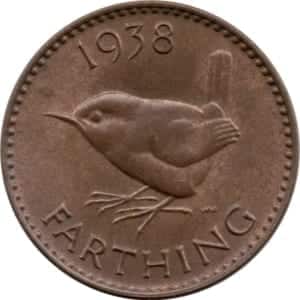
The Britannia design remained through the reigns of both King Edward VII and King George V before being finally changed to the much-beloved wren design at the beginning of King George VI’s reign in 1937. The wren remained as the farthing’s reverse design until it was declared to no longer be legal tender in 1961.
When Was The Farthing Discontinued?
Part of what makes the farthing so interesting is that it was phased out of circulation 10 years prior to the decimalisation of the UK currency system in 1971.
This was due to inflation in the 1950s that resulted in the farthing’s purchasing power decreasing. In a similar way to how you wouldn’t pay for something nowadays entirely in pennies, stories began to emerge of annoyed vendors that were being paid by customers in farthings.
It was clear that the farthing had lost its popularity and demand for mintage began to dwindle. The production of the farthing was officially discontinued in 1956, and the coin ceased to be legal tender as of January 1st 1961.
What Is A Farthing Worth In Today’s money?
Farthings were worth 1/4 of a penny, as previously mentioned, and before decimalisation there were 240 pennies to a pound.
Therefore in today’s money a farthing translates to a value of 0.10 pence rounded down. Luckily for us, farthings are worth much more than this due to their collectable value.
How Much Are Farthings Worth To Collectors?
The value of a farthing is largely dependent on the year it was minted.
For the purpose of this article we’ll focus on the modern farthing which was minted from 1860 onwards as these are much more common and easier to categorise.
‘Bun Head’ Victoria Farthing, 1860-1879
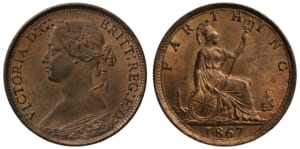
The first modern farthings cast in bronze featured a portrait of the original ‘bun head’ design of Queen Victoria on the obverse.
The mintage of this particular version of the coin is unknown but they are certainly still sought after. Some farthings in this series sell for over £200 in uncirculated condition.
‘Bun Head’ Victoria Farthing, 1880-1895
Despite still depicting the same ‘bun head’ Victoria on the obverse and the same Britannia design on the reverse, farthings that were minted from 1880 to 1895 have a higher value.
Whilst the official mintage figures are also unknown, it is understood that they are less than the farthings produced in the previous years, and some coins in this series – like the 1895 farthing – can sell for over £300 uncirculated.
‘Old Veiled Head’ Victoria Farthing, 1895-1901
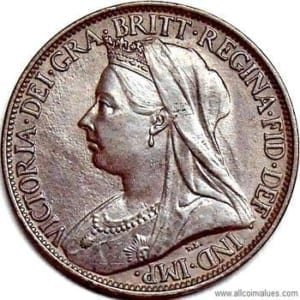
In 1895, the obverse design of the farthing was revamped to match the new official portrait of Queen Victoria. The design became known as ‘old veiled head’ Victoria, a reference to her prolonged morning of her late husband Prince Albert.
Despite only being minted for 7 years, the coins from this era are among the cheapest farthings available. Between 2-5 million farthings were minted each year between 1895-1900, with a whopping 8 million being created in the year of Victoria’s death in 1901.
The very highest graded examples in this series sell for up to £30.
Edward VII Farthing, 1902-1910
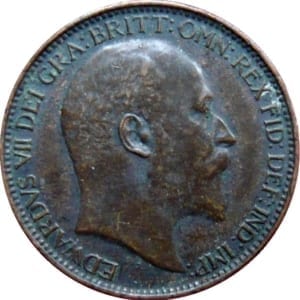
The death of Queen Victoria finally led to a change in portrait on the obverse of the farthing, with Edward VII’s bare head now proudly displayed.
The coins show his portrait facing to the right, the opposite of Queen Victoria’s portrait in line with the official monarch rules for appearing on coins.
Approximately 5 million farthings were printed for each year of his reign and the highest graded examples of this series sell for up to £100.
George V Farthing, 1911-1936
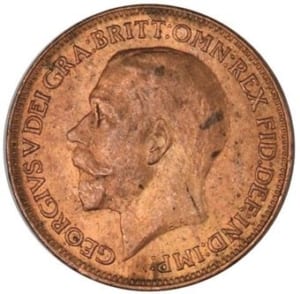
The introduction of the George V farthing in 1911 saw the mintage figures rapidly increase. Around 9 million farthings were minted for each year of his reign with a record 21 million being printed in 1917.
It should be unsurprising that these increased mintage figures led to a decrease in the value of the farthing from this era. These farthings sell for around £1 in VF, but can sell for almost £20 in uncirculated finish,
George VI Farthing, 1937-1952

The year 1937 finally saw the arrival of the beloved wren design along with the portrait of George VI on the obverse. Despite the iconic design, these farthings are far from rare with mintage figures being as high as 33 million in a single year.
Even the most sought-after farthings in this series are worth just £10 in the best grading possible.
Elizabeth II Farthing, 1953-1956
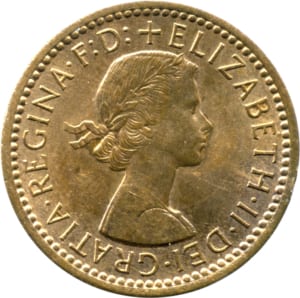
The reign of Elizabeth II saw the final versions of the farthing created which retained the much-loved wren design. Due to the decreasing value and popularity of the farthing at the time, the mintage of the farthing dropped to around 5 million a year.
In its final year of production, only 2 million farthings were produced and these are unsurprisingly the most sought after of this particular era. Highly graded farthings produced in 1956 can fetch up to £10 in some cases, with the rest of the coins hovering around £1.
Most Valuable Farthings
If you’re on the lookout for the most valuable farthings then you need to look at those issued before 1860.
Charles II Farthings
Farthings minted during the reign of Charles II are highly valuable, with highly graded specimens being worth over £1,000 in some cases.
James II Farthings
James II farthings are also extremely rare.
Certain years, such as 1685 and 1686, are particularly rare and sell for over £2,000 when highly graded.
William And Mary Farthings
All farthings issued during this reign are considered to be rare, with 1690 and 1692 versions worth over £3,000 with a high grade.
Final Thoughts
The farthing is a classic coin that has undergone many changes during its active years as part of the UK currency system. If you’re lucky enough to have any, it’s worth checking the dates as you could be in with a small profit.
If you have any questions, don’t hesitate to contact us here.
